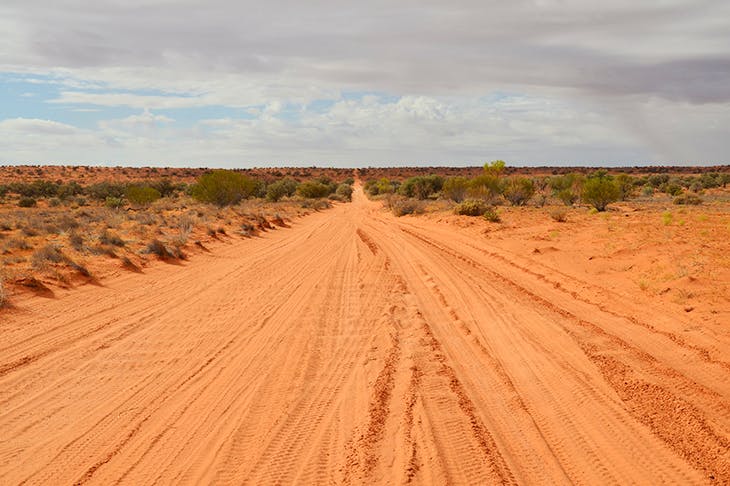On the website of the Australian National University in Canberra, emeritus professor of history Barry Higman lists his research interests as food sciences, cultural studies and historical studies, with a particular interest in
The world history of food over the last 5,000 years; the global history of domestic servants in the modern world; the history of the Jamaican landscape; the history of Australia as a flat place; and the history of islands and insularity.
This rather unusual breadth of interests suggests either that Professor Higman is a very curious man indeed or a complete academic fraud. Fortunately, for the sake of the future of higher education in south-eastern Australia, it’s the former. Flatness is the uneven, fascinating work of a true scholar enthusiast. Flatness: effervescent.
‘I cannot see a plain without a shudder:/ O God, please, please don’t ever make me live there,’ wrote Auden in one of his ‘Bucolics’. (Auden of course famously preferred a limestone landscape, with its ‘rounded slopes’ and ‘secret system of caves and conduits’. Take from that what you will.) Higman is the opposite of Auden. He loves plains of every kind: Flatness is an investigation of what he calls ‘pervasive planarity’, from naturally occurring plateaus to engineered plane surfaces.
There is, for example, an entire chapter on ‘Level Playing Fields’, which describes and analyses the level surfaces required for running, riding, table tennis, chess and football, etc., in which he usefully identifies an aspect of most modern sports which explains exactly why they’re all so bloody boring:
Standardisation stemmed both from a political desire for social control and from a growing impulse to measure and compare … Modern sports are … highly repetitive in their elements, taking the spectator to the edge of monotony by requiring that the fundamental conditions be the same in each iteration.
Ah. So that’s why I love cage fighting.
The book concludes with a brilliant but rather depressing chapter on ‘Future Flatness’ — a world in which ‘linearity has little meaning’ and Japanese design and the music of Kraftwerk will have triumphed over all. But my own favourite chapter is the accurately titled ‘Very Flat Places’, in which Higman compares and contrasts the various flat landscapes of the African savannah, the American Great Plains, Australian deserts, the Tibetan Plateau, the Russian steppes, the Low Countries, Siberia and the English fens, and offers a range of insights into the geographical and cultural determination of aesthetic preferences, their relationship with human survival instincts, and the connection between spaciousness and freedom. He notes that ‘Whether positive or negative, literal or metaphorical, the essential element of flatness is the notion of invariance.’ Clearly the essential element of Flatness is the notion of variance. I can think of few books where the discussion ranges from abstract expressionism to flat earth theories, microtopography and hunting.
Perhaps most remarkably, given the obvious potential in the subject matter for sky-high geyser-spouting nonsense, the book is almost entirely free of sub-philosophical cant and cultural studies jargon. Even at his most polemical, Higman manages to write with admirable clarity and precision.
Flatness means profit for manufacturers, distributors and retailers […] From the bottom to the top — from flat files, to the smallest frozen food box, to the offices in the tallest skyscraper — space is divided into straight-sided units that can be fitted together.
And in one of those insights that occurs only to someone who has spent perhaps too long with a subject and then suddenly realises that which is utterly obvious to the rest of us, Higman remarks:
The tension lies in the word itself. On the one hand, ‘flatness’ indicates smoothness, evenness, levelness and predictability, all useful characteristics that facilitate movement and activity, things that contribute to social and economic efficiency. At the same time, it identifies corollaries such as monotony, homogeneity, sameness, emptiness, absence, lack, insipidity, dullness, deficiency, tedium, boredom and even deadness.
The book is therefore original and surprising but also reassuringly sane and straightforward, occupying a rather unusual place somewhere between, say, Bachelard’s The Poetics of Space, Tanizaki’s In Praise of Shadows and Henry Petroski’s books on engineering. There may be few readers who are willing or able to follow Higman all the way as he strides confidently across the various fields of ontology, geomorphology, physiology, theology, the philosophy of science, and discussions both of the techniques of profile measurement and the meaning of musical and pictorial flatness, but those who do will find the long journey across this vast territory worthwhile.
Got something to add? Join the discussion and comment below.
Get 10 issues for just $10
Subscribe to The Spectator Australia today for the next 10 magazine issues, plus full online access, for just $10.
You might disagree with half of it, but you’ll enjoy reading all of it. Try your first month for free, then just $2 a week for the remainder of your first year.














Comments
Don't miss out
Join the conversation with other Spectator Australia readers. Subscribe to leave a comment.
SUBSCRIBEAlready a subscriber? Log in